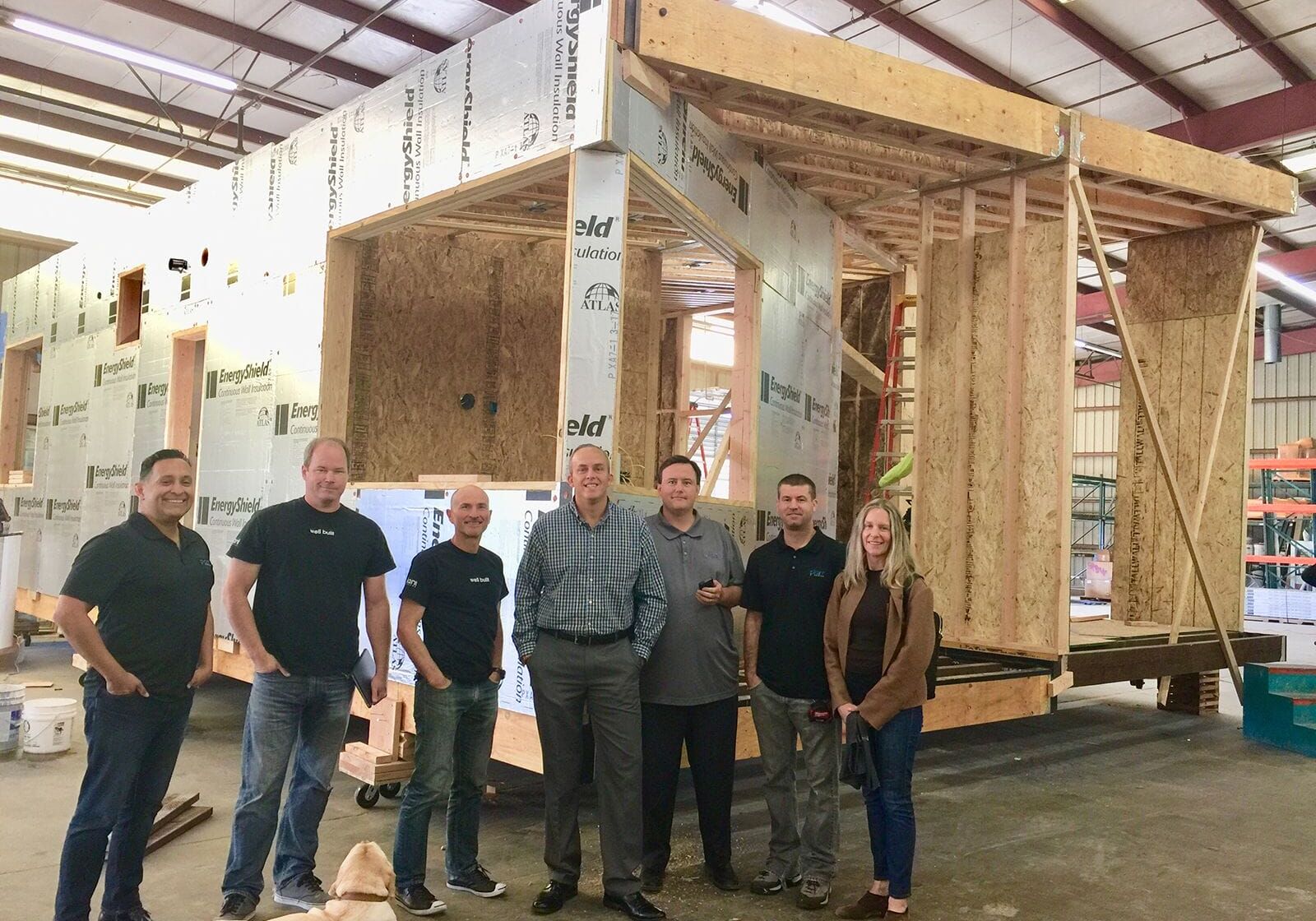Collaboration — How to Do It Right
Collaboration in the Modular Construction Industry

Landon Boucher is the Director of Business Design and Innovations at MiTek Inc.
So much is said in the world of construction regarding the need to collaborate, particularly in off-site construction. Anyone experienced with successful project execution will tell you that good collaboration amongst project team members, will yield quantitative results. Some in our industry have taken the time to dive deeper into exactly what that means and the impact it can have on a project. What seems to be missing often from these presentations and marketing campaigns is real, tangible direction on, “how” – how to collaborate. I have witnessed many project teams miss the intended results of a project due to a poorly guided, albeit well intended, attempt at collaboration. Usually, these failed projects start with a lot of enthusiasm from the team members to share respective knowledge and insights in their aim toward a successful outcome. The definition of success can vary depending on the expectations laid out by the customer, but regardless of how its defined, success can subtly slip away from the team without a clear understanding of “how.”
There are several high-quality tools and resources on the market that can aid a team in their collaborative efforts, including some from MiTek regarding structural building components. Still, no matter how great these tools are, if little is understood about how to extract all capabilities from these tools and maximize outputs, even if improved results are seen, the full potential is missed. One obvious solution is including someone on the team who has advanced level expertise in this area. Sometimes however, that just isn’t available. In those cases, a representative from the company that developed and maintains that tool, is a necessary member to add, even if it is someone only available remotely to troubleshoot as needed. Still, even more important than understanding how to take full advantage of the capabilities available within the many tools and resources our industry provides, is an understanding of how to apply the general principles of collaboration. More than just another industry buzzword, collaboration is a process that requires leadership to maintain its implementation through project completion.
So how can you establish good collaboration? First you must determine what sort of collaboration your project will benefit from most. The two main types are Open and Closed. Open collaboration involves utilizing people from inside and outside your organization to generate ideas or solve problems. This type of collaboration usually involves a large number of participants. A common use of this type of collaboration would be market research. Closed collaboration, however, involves using a relatively small group of specialists working toward a common goal. Closed collaboration is what you would typically see on a construction project team. A relatively small group of specialists, working toward a common goal, to design, make and build a high performing building that produces a financial net gain for the owner.
Once you’ve defined the type of collaboration you will need, you must select the right people and begin building your team. Take careful consideration of the value of the work they provide, not just the bid. A good structural engineer for instance can spend twice the amount of time to complete a project but in that time, remove 100’s of 1,000’s of dollars from your construction budget. What matters more? The cost to design a project or the cost to build it? Even though in a collaborative environment, you want to have equal participation amongst all members of the team, it is important to still assign leadership roles to ensure the project stays on track. This is particularly important in our industry where the options can often seem endless regarding design choices and construction methodologies.
Now that your team is selected, its time to define your purpose. We can’t be successful in our “how” without defining our “why”. Share your mission and vision for the project and have it written down as the header of all communications going forward. A shared mission will keep the team together and a shared vision will help them arrive at the right destination.
Lastly, once the mission and vision have been identified, you will need to deliver it with conviction to generate buy-in from all participants. If you believe it, make it known and make it owned! As the leader of the project, you will need to set the example, build trust, and show consistency if you are going to be successful in establishing a creative and supportive culture that is rooted in the principals of collaboration.
I’ll share one final thought about leadership. While this article is focused on collaboration, the success of collaboration relies on leadership. Everything rises and falls on leadership! There is an old paradox known as Buridan’s Donkey. It’s named after the author, Jean Buridan who was a 14th century philosopher and a student of Aristotle. Buridan’s Donkey is an illustration of a paradox in philosophy regarding the concept of free will or the power to make choices. It refers to a hypothetical situation wherein a donkey that is equally parts hungry and thirsty is placed exactly midway between its food source and its water source. The paradox assumes that the donkey will always default to whatever is closest (or easiest to access). Ultimately, it dies of both hunger and thirst since it cannot make a rational decision between the food or the water. Jean Buridan was a great humorist and would regularly use humor to illustrate his philosophical teachings. While humorous, this paradox of the donkey, holds a lot of wisdom. We have all experienced the famous “analysis paralysis” dilemma on project teams. I think the point Buridan is making here in this paradox, is choices must be made. Sometimes, the easy choice isn’t the best. Regardless, you have to take decisive action. You have to move. You have to lead.
So, don’t be a donkey! Make decisions and lead your team to success through collaboration.
If you are interested in collaborating with MiTek, contact me at Landon.Boucher@mii.com
More from Modular Advantage
Resia: Breaking All the Rules
Resia Manufacturing, a division of U.S.-based Resia, is now offering prefabricated bathroom and kitchen components to industry partners. Its hybrid fabrication facility produces more precise bathroom and kitchen components (modules) faster and at lower cost than traditional construction. Here’s how Resia Manufacturing does it.
How LINQ Modular Innovates to Bring Modular To The Market in the UAE and Beyond
LINQ Modular, with an office and three manufacturing facilities in Dubai, is a modular firm based in United Arab Emirates. The company is on a mission: to break open the housing and construction markets in the Gulf Cooperation Council (GCC) area with modular.
ModMax: Redefining Modular Construction with Confidence and Precision
ModMax was born out of frustration—frustration with five persistent pain points in modular construction: Permitting bottlenecks. Production delays. Rigid designs. Disconnect between “the office” and the field. Lack of transparency and communication.
LifeArk: Disaster-Resilient Housing from Recycled Plastic and 100-year-old Technology
Wee compares LifeArk’s housing units to Yeti coolers, as they are built similarly. Each component takes 15 to 20 minutes to manufacture, has an R-value of 40, and includes molded slots and chases for wiring, plumbing, fire sprinklers, and other utilities.
Building the Future of Modular Edge Infrastructure
The edge data center market is expanding rapidly, driven by the surge in AI workloads, IoT adoption, and the need for localized compute power. In these environments, sustainability, scalability, and reliability are non-negotiable. Cooling is among the most complex challenges for operators—and one of the most decisive factors in long-term success.
Accelerating Light-Gauge Steel Construction: A Semi-Automated Digital Workflow for Off-Site Projects
For construction professionals, the message is clear. By adopting semi-automation and digitalization, companies can deliver projects faster, more accurately, and more profitably, while also building stronger collaboration across teams. The approach is not about replacing people with machines, but about empowering people with better tools and processes.
Why Modular Data Centers Are Gaining Momentum
Artificial intelligence, high-performance computing, and edge applications push the limits of traditional “stick-built” data centers. They take years build, often struggle with high density workloads, and aren’t optimized for deployments near end users. Modular data center platforms are purpose-built to address these challenges, offering flexibility and scalability to adapt to evolving technologies, while opening new opportunities for the modular construction industry.
Supply Chain Innovation in Action: 5 Habits Every Modular Leader Should Practice
By applying these principles to supply chain practices — collaborative planning, strategic procurement, scenario modeling, digital tools, and transparent forecasting — construction leaders can build value chains that are not just efficient and agile, but truly innovative.
Exploring the Role of Modular Integrated Construction (MiC) in Advancing Circular City Principles – A Survey of Stakeholder Perspectives
The survey findings highlight the significant potential of Modular integrated Construction (MiC) in advancing the development of circular cities. By reducing costs, accelerating construction timelines, and minimizing waste generation, MiC offers a promising approach to sustainable urban development.
The Use of MS POLYMER™-Based Sealants and Adhesives in Modular Building
These products combine flexibility and elastic recovery with excellent adhesion to different substrates and have already shown their usefulness in traditional construction. Now it’s time for them to be put to use in the modular construction industry.











